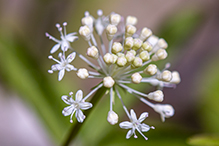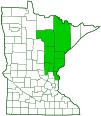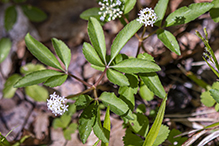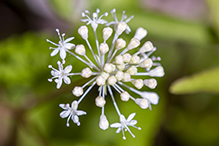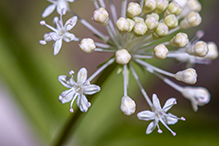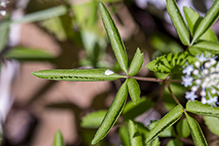dwarf ginseng
(Panax trifolius)
Conservation • Description • Habitat • Ecology • Use • Distribution • Taxonomy
Conservation Status |
|
|||||||
| IUCN Red List | not listed |
|||||||
| NatureServe | N4N5 - Apparently Secure to Secure SNR - Unranked |
|||||||
| Minnesota | not listed |
|||||||
Description |
||
Dwarf ginseng is a small woodland spring wildflower. It occurs in the United States from Maine to Minnesota, south to New Jersey and Illinois, in adjacent Canadian provinces, and in the Appalachian region south to to Georgia. It is uncommon in east-central Minnesota, absent from the remainder of the state. It grows in shade or partial shade, in moist, well-drained soil, in rich deciduous woodlands and bottomland forests. Dwarf ginseng is an erect, perennial forb that rises on a single stem from an underground, globe-shaped, thickened root (tuber). It can be 4″ to 12″ but is usually no more than 8″ in height. The stem is green to red, hairless, and unbranched. There is a single whorl of three leaves. They are on ¾″ to 2″ long leaf stalks, and are held more or less parallel to the ground. They are divided into 3 to 5 leaflets that radiate from a single point (palmate). The species epithet trifolius means “three leaves”, and this refers to the compound leaves, not the leaflets. The larger leaves usually have 5 leaflets. The leaflets are stalkless or nearly stalkless, lance-shaped to elliptic or inversely egg-shaped, and 1 9 ⁄16″ to 3⅛″ (4 to 8 cm) long. The middle leaflet is the largest. When there are 5 leaflets, the lower lateral leaflets are the smallest. The leaflet blades are tapered at the base, widest beyond the middle, and usually broadly pointed at the tip. The upper surface is hairless. The margins are finely toothed. The inflorescence is a single rounded, ½″ to ¾″ in diameter, umbrella-shaped cluster (umbel) of flowers rising on a ¾″ to 3⅛″ (2 to 8 cm) long stalk (peduncle) above the whorl of leaves. The umbel has either all male flowers or all flowers with both male and female parts (perfect flowers). The stalks of each individual flower are white. Each flower is about ⅛″ wide. There are 5 sepals, 5 petals, and 5 stamens. The sepals are white and are fused into a short tube (calyx). The calyx may have 5 minute teeth or appear toothless. The petals are oblong elliptic and widely spreading or somewhat bent backwards. They are white when fresh and turning pale pink as they age. The stamens have white stalks (filaments) and white anthers. They extend well above the petals. Perfect flowers have 3 long fertile styles that are separated, not fused, for their entire length. Male flowers have 1 short style that is not functional. The fruit is 3 ⁄16″ (5 mm) thick, yellow, berry-like, and fleshy (drupe) with 2 or 3 stones. |
||
Height |
||
4″ to 12″ |
||
Flower Color |
||
White to pale pink |
||
Similar Species |
||
|
||
Habitat |
||
Moist. Rich deciduous woodlands, bottomland forests. Shade or partial shade. Well-drained soil. |
||
Ecology |
||
Flowering |
||
May to June |
||
Pests and Diseases |
||
|
||
Use |
||
|
||
Distribution |
||||
|
Sources |
|||
| 4/13/2023 | ||||
Nativity |
||||
Native |
||||
Occurrence |
||||
Uncommon |
||||
Taxonomy |
|||
| Kingdom | Plantae (green algae and land plants) | ||
| Subkingdom | Viridiplantae (green plants) | ||
| Infrakingdom | Streptophyta (land plants and green algae) | ||
| Superdivision | Embryophyta (land plants) | ||
| Division | Tracheophyta (vascular plants) | ||
| Subdivision | Spermatophytina (seed plants) | ||
| Class | Magnoliopsida (flowering plants) | ||
| Superorder | Asteranae | ||
Order |
Apiales (carrots, ivies, and allies) | ||
Family |
Araliaceae (ivy) | ||
| Subfamily | Aralioideae | ||
| Tribe | Aralieae | ||
Genus |
Panax (ginsengs) | ||
| Subgenus | Trifolius | ||
Subordinate Taxa |
|||
|
|||
Synonyms |
|||
|
|||
Common Names |
|||
dwarf ginseng groundnut |
|||
Glossary
Calyx
The group of outer floral leaves (sepals) below the petals, occasionally forming a tube.
Compound leaf
A leaf that is divided into leaflets, each leaflet having the general appearance of a leaf, with all leaflets attached to a single leaf stem.
Filament
On plants: The thread-like stalk of a stamen which supports the anther. On Lepidoptera: One of a pair of long, thin, fleshy extensions extending from the thorax, and sometimes also from the abdomen, of a caterpillar.
Palmate
Similar to a hand. Having more than three lobes or leaflets that radiate from a single point at the base of the leaf.
Tuber
An underground root (as with dahlias) or stem (as with potatoes), thickened by the accumulation of reserved food (usually starch), which serves for food storage and vegetative propagation.
Umbel
A flat-topped or convex, umbrella-shaped cluster of flowers or buds arising from more or less a single point.
Whorl
A ring-like arrangement of similar parts arising from a common point.

Slideshows |
||

Visitor Videos |
|||
Share your video of this plant. |
|||
| This button not working for you? Simply email us at info@MinnesotaSeasons.com. Attach a video, a YouTube link, or a cloud storage link. |
|||
Other Videos |
|||
| Edible & Medicinal Dwarf Ginseng ( Panax trifolius ) Prepare2Survive |
|||
About
Apr 19, 2012 Dwarf Ginseng: A little known wild adaptogen https://www.youtube.com/watch?v=7-lADScTtmA |
|||
| Dwarf Ginseng (Panax trifolius) video wvoutdoorman |
|||
About
Apr 7, 2012 Dwarf Ginseng (Panax trifolius) in bloom and I show the root of this unique plant |
|||
| Capital Naturalist: Dwarf Ginseng Capital Naturalist |
|||
About
Apr 11, 2016 Dwarf Ginseng (Panax trifolius) is a spring blooming woodland wildflower that is not very common to find. It is not used however in the same way as its larger Ginseng cousin. |
|||
| Dwarf Ginseng and real Ginseng meds Mike Reed Outdoors |
|||
About
Jun 5, 2018 This video is about Dwarf Ginseng and real Ginseng meds |
|||

Visitor Sightings |
|||||
Report a sighting of this plant. |
|||||
| This button not working for you? Simply email us at info@MinnesotaSeasons.com. Be sure to include a location. |
|||||
|
|||||
MinnesotaSeasons.com Sightings |
|||||

Created: 11/20/2019
Last Updated:
